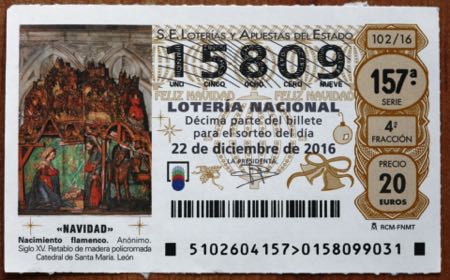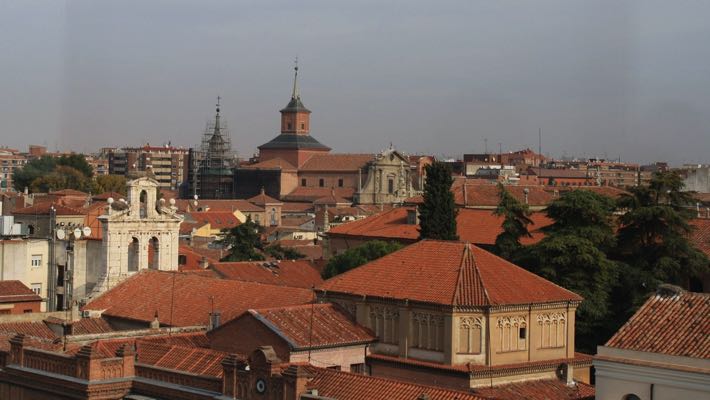 Most people would love to win the lottery, even if they don’t actually buy tickets for it all that often. The idea of winning millions, or even tens of millions, of pounds appeals to many people, bar the select few that think that it wouldn’t make them much happier. For the majority, the notion of winning a huge sum of money would allow them to give up work, holiday regularly or generally just do things that would see stress removed from their lives. Imagine how people would feel, therefore, were they to win El Gordo, the largest lottery in the world that regularly promises a share hundreds of millions in prize money.
Most people would love to win the lottery, even if they don’t actually buy tickets for it all that often. The idea of winning millions, or even tens of millions, of pounds appeals to many people, bar the select few that think that it wouldn’t make them much happier. For the majority, the notion of winning a huge sum of money would allow them to give up work, holiday regularly or generally just do things that would see stress removed from their lives. Imagine how people would feel, therefore, were they to win El Gordo, the largest lottery in the world that regularly promises a share hundreds of millions in prize money.
The lottery, which is held during the Christmas period, has been running for more than 100 years. The idea behind the draw is that as many people as possible should win a small amount, perhaps allowing them to break even. It is common for bars, associations and companies to share tickets between them, given that the top ticket, at €200, costs a little too much for many. With total prize money regularly hitting the several billion mark, it’s little wonder that it is one of the most exciting and talked about lotteries in the world. The question is, how did it originate, why did it grow so big and how does it work?
The Origins of the Christmas Lottery

There aren’t many lottery draws that were created in order to allow the organising country to fight a war, but that’s exactly what happened with the Spanish Christmas Lottery. Often referred to simply as ‘El Gordo’ by some, that is a slight misnomer, given that El Gordo is the title given to any lottery jackpot in Spain. It was created in 1812 in the Spanish city of Cádiz, with the purpose being to give the Andalusian locale the chance to buy bullets and build cannons that would give them a chance to fight off Napoleon.
Created in 1812 in Cádiz
Cádiz had become the location for the Spanish government, which was in exile at the time, resorted to creating a lottery in order to come up with the funds to cover the cost of the war that was being waged against the Napoleonic army. Gervasio Gasca came up with the idea, hoping that it would allow for the alleviation of the displaced people of Spain at the time, as well as the reinforce support for the resistance. The idea of a lottery in and of itself wasn’t new, but the notion of a lottery specifically at Christmas certainly was.
Handcrafted Wooden Balls
The lottery had its opponents during its formative years, with many hoping for a more ‘desirable’ means of ‘sustaining public necessities’. In spite of these moral arguments, the need for money won out and in 1812 the government ordered the production of 25,000 numbered wooden balls. Winners had previously been chosen with rolled up paper, but the handcrafted balls replaced them and Spain’s first Christmas lottery took place on the 18th of December in 1812. Number 03604 won, with the winners getting 8,000 Spanish dollars.
Headquarters Move to Madrid
That wasn’t bad for a 40 Spanish dollar investment. The war in Spain continued to rage after the end of 1812, leading to the lottery being spread to the rest of the country. When the war was reaching its climax in 1814, the headquarters of the lottery moved from Cádiz to Madrid, which Spanish troops had retaken from the French forces. Even after the war was won, the lottery continued to be played. It soon became a Spanish tradition and the draw has taken placed on the 22nd of December every year since, up to modern day.
How the Lottery Works

The Sorteo Extraordinario de Navidad, often referred to simply as the Lotería de Navidad, is a special draw of the weekly National Lottery in Spain. It is run by the Loterías y Apuestas del Estado on behalf of the Spanish government and is easily the most popular draw of the year. It is the second-longest continuously running lottery in the world and is the biggest in the world, based on total prize money paid out. All of the tickets have five-digit numbers printed on them, but each ticket can be sold more than once.
Only 100,000 Unique Tickets Printed
The numbers range from 00000 to 99999, which means that just 100,000 unique tickets can be printed. As a result, several series’ are printed. In 2019, for example, there were 170 series’ printed, offering a total of 17 million tickets priced at €200 each. The government takes a 30% cut of the tickets, meaning that 2019 had a total prize fund on offer of €2.38 billion. Obviously, €200 is a lot for most people, so tickets are sold with ten sub-tickets that are on perforated tear-apart sections of the ticket, sold for €20 apiece.
Shops Sell Tickets from the Same Series
The smaller tickets are known as a décimo and entitled the holder to 10% of whatever prize ends up being won by the ticket. Tickets for the lottery are sold by administraciones, or lottery shops, as well as on the street by both licensed and unlicensed sellers. It is common for shops to sell tickets from the same series, meaning that if that number wins then everyone that bought their ticket from that shop will be a winner. This adds to a sense of community amongst players of the game, knowing that if they win others will win too.
Shares in Tickets
Even €20 can be too much for some, so many people will buy what is known as a participación, or a share in a ticket. This will often be done in workplaces, cafés, shops and so on. They are sold by writing the ticket number and the amount paid onto a piece of paper, which can often be a photocopy of the original ticket, with these pieces of paper being considered a legal contract in Spain. Anyone holding a share of a winning ticket will be entitled to a proportionate amount of prize money, depending on how much they paid.
It’s a Complicated System
It is fair to say that the Spanish Christmas lottery is a complicated one to get your head around. Perhaps the best way to explain it is to look at the 2019 draw and show the breakdown of the various prizes that were won. Here we’ll look at the number of tickets that were won, the amount that each ticket received, the total paid out and a brief description of what each ticket was for, as well as the odds. This will, in theory at least, make it easier to explain the manner in which the Christmas lottery works in Spain.
| Number of Winning Tickets | Prize Money | Total Prize Money Paid | Description of Ticket | Odds |
|---|---|---|---|---|
| 1 | €4,000,000 | €4,000,000 | El Gordo | 1 in 100,000 |
| 1 | €1,250,000 | €1,250,000 | Second Prize | 1 in 100,000 |
| 1 | €500,000 | €500,000 | Third Prize | 1 in 100,000 |
| 2 | €200,000 | €400,000 | Fourth Prize | 1 in 50,000 |
| 8 | €60,000 | €480,000 | Fifth Prize | 1 in 12,500 |
| 1,794 | €1,000 | €1,794,000 | La Pedrea | 1 in 56 |
| 2 | €20,000 | €40,000 | For the two numbers one unit above the First Prize and one below | 1 in 50,000 |
| 2 | €12,500 | €25,000 | For the two numbers one unit above the Second Prize and one below | 1 in 50,000 |
| 2 | €9,600 | €19,2000 | For the two numbers one unit above the Third Prize and one below | 1 in 50,000 |
| 99 | €1,000 | €99,000 | For the 99 numbers that share the first three digits of the First Prize | 1 in 1,010 |
| 99 | €1,000 | €99,000 | For the 99 numbers that share the first three digits of the Second Prize | 1 in 1,010 |
| 99 | €1,000 | €99,000 | For the 99 numbers that share the first three digits of the Third Prize | 1 in 1,010 |
| 198 | €1,000 | €198,000 | For the 99 numbers that share the first three digits of all of the Fourth Prizes | 1 in 505 |
| 999 | €1,000 | €999,000 | For the 999 numbers that share the last two digits of the First Prize | 1 in 100 |
| 999 | €1,000 | €999,000 | For the 999 numbers that share the last two digits of the Second Prize | 1 in 100 |
| 999 | €1,000 | €999,000 | For the 999 numbers that share the last two digits of the Third Prize | 1 in 100 |
| 9,999 | €200 | €1,999,800 | For the 9,999 numbers that share the last digit of the First Prize | 1 in 100 |
As you can see, it’s a lottery that tries to pay back as much money as possible to as many players as possible, with the final prize being the equivalent of a refund. You can imagine that if you had a share of a ticket that ended up winning El Gordo, the top prize, then you’ll win a decent chunk of money. If you decided not to sell shares of the ticket and kept it for yourself, you’d walk away with an even larger sum that would surely amount to an enormous sum that most people could not even imagine.
The Big Winners

The ceremony around the Spanish Christmas lottery takes about three hours, with schoolchildren drawing the numbers and singing the results. There are two hoppers that are used, with one containing the winning numbers and the other the prize that they will receive. There have been several occasions on which the main jackpot, El Gordo, was worth around €700 million and was shared between 1,600 people, each receiving about €400,000. Here’s a look at a time that the cava was sent spraying:
The Town That Won Big
In 2012, the overall prize payout for the Spanish Chistmas lottery stood at around €2 billion. That is impressive in and of itself, but the top prize was worth an eye-watering €720 million. That was about 43% of the total prize pool and was won by residents in an historic town called Alcala de Henares, just outside of Madrid. Because of the Spanish tradition of buying shares of a ticket rather than a ticket outright, the joy of winning was shared amongst the residents of the town, though that isn’t always the case.
There was one person, for example, who bought a full ticket, but gave them away to family members. As a result, the family shared close to €5 million between them. It could certainly be said that the biggest winner that year was the Spanish government, which kept more than €900 million, or 30%. The prize in 2012 was even better than in the years that followed, thanks to the fact that it was the last year in which winnings were tax free. That changed from 2013 onwards, though a win remains worth celebrating.